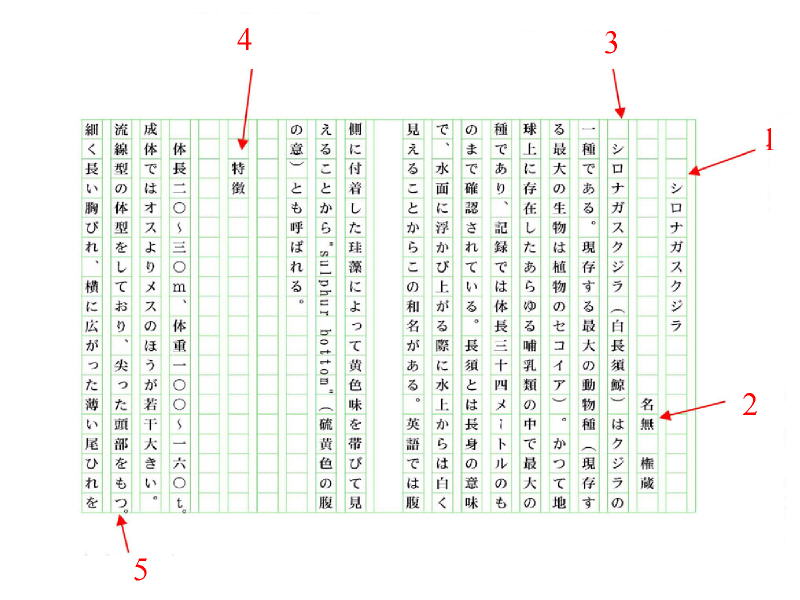- Genkō yōshi
nihongo|"Genkō yōshi"|原稿用紙, literally manuscript paper is a type of Japanese paper used for writing. It is printed with squares, typically 200 or 400 per sheet, each square designed to accommodate a single
Japanese character or punctuation mark. "Genkō yōshi" may be used with any type of writing instrument (pencil ,pen orink brush ), and with or without a "shitajiki ".While in the past "genkō yōshi" was used for all types of manuscript writing (
essay s,creative writing , news writing and so on), in most cases the advent of thecomputer means that this is now the preferred medium, although some Japanese word processing software still includes a "genkō yōshi" template. However, "genkō yōshi" is still very widely used, especially by students. Primary and secondary students in particular are required to hand in assignments written on "genkō yōshi", and essays for school entrance examinations are also written on the paper, making knowledge of the correct way to use "genkō yōshi" essential.Some programmes of Japanese as a foreign language also require or encourage their adult students to use "genkō yōshi" for practice or formal assignments or both, as use of the paper helps students to learn correct spacing when writing vertically.
Form
"Genkō yōshi" is used for vertical writing (although by turning the page sideways it can be used for horizontal writing too), and is most commonly printed in lines of twenty squares, with ten lines per page (each B4-sized sheet of "genkō yōshi" comprising two pages), but other configurations are also available. Between each line of squares is a blank space used for writing
furigana (ruby character s),bōten (a type of punctuation mark used for giving emphasis) or other marks.In the centre of each sheet of "genkō yōshi" (between the two sets of ten lines) is a wide blank space, allowing the sheets to be folded or bound.
right|thumb|450px|">Correct use of genkō yōshi (400 square sheet shown):
1. Title on the 1st line, first character in the 4th square.
2. Author's name on the 2nd line, with 1 square between the family name and the given name, and 1 empty square below.
3. First sentence of the essay begins on the 3rd line, in the 2nd square. Each new paragraph begins on the 2nd square.
4. Subheadings have 1 empty line before and after, and begin on the 3rd square of a new line.
5. Punctuation marks normally occupy their own square, except when they occur at the bottom of a line, in which case they share a square with the last character of the line.Origin
Prior to the
Edo period , handwriting was often calligraphic and written materials often made use of scrolls, which would have made the guidelines printed on "genkō yōshi" a hindrance, although paper was sometimes printed with vertical lines designed to keep lines of vertical writing straight."Genkō yōshi" came into common use in the middle of the
Meiji period with the rising importance of newspapers and magazines, and the attendant need to count characters precisely.Rules for use
While "genkō yōshi" can be used for horizontal writing, it is most commonly used for vertical writing, which is read from right to left. The first page is therefore the right hand side of the sheet. The title is placed on the first line, leaving three blank spaces. The author's name is placed on line 2, with an empty square below and an empty square between the given and family names. The first sentence begins on line 3, after a blank square. Each new paragraph is placed on a new line, and starts on the second square.
Full stops, commas, and small
kana are placed in the top right corner of their own square. All punctuation marks, other marks (such as parentheses), and small kana usually occupy their own square, unless this would place them at the top of a new line, in which case they share the last square of the previous line with the character in that square. A blank square is left after non-Japanese punctuation marks (such as exclamation points and question marks). Ellipses and dashes use two squares.Furigana are written to the right of the relevant character, in small print.
Western characters (such as the
Roman alphabet ) are written vertically by turning the page a quarter turn to the right, so that when the page is viewed normally they are sideways. Each square can accommodate two Western characters."Genkō yōshi" and manga
Mangaka and other illustrators also use a special type of "genkō yōshi" calledmanga "genkō yōshi". This paper is printed with very light blue lines which do not show up when copied, and there are several varieties, each with a different type of printed grid. These are also available in different weights and sizes.ee also
* "
Shitajiki "
* "Washi "*
Loose leaf
*Ruled paper
*Writing paper References
* Seward, Jack. "Easy Japanese: A Guide to Spoken and Written Japanese". 1993 Passport Books, Chicago.
* New College Japanese-English Dictionary, 5th Edition, Kenkyusha
Wikimedia Foundation. 2010.

